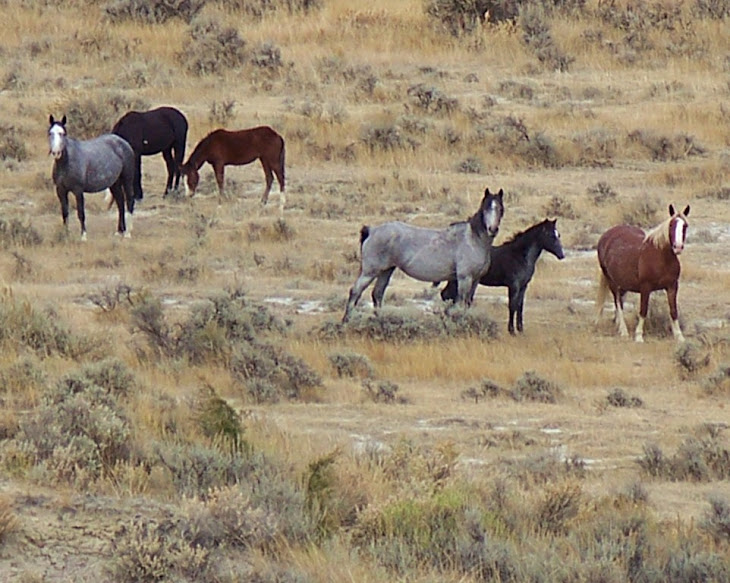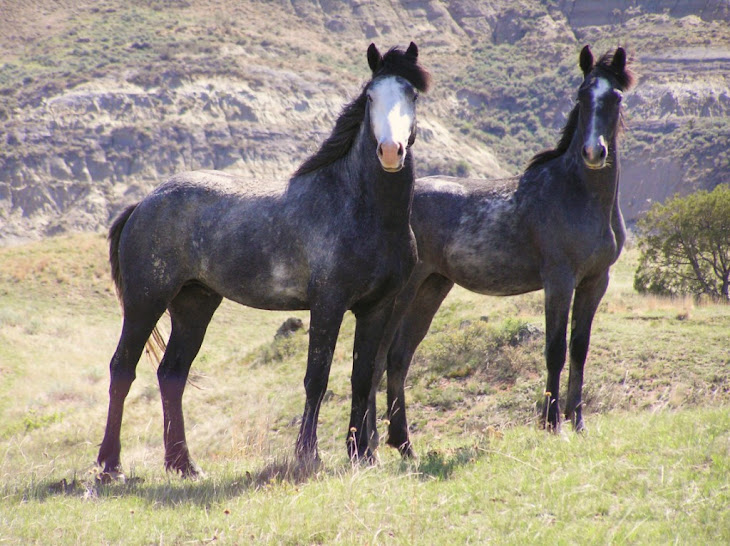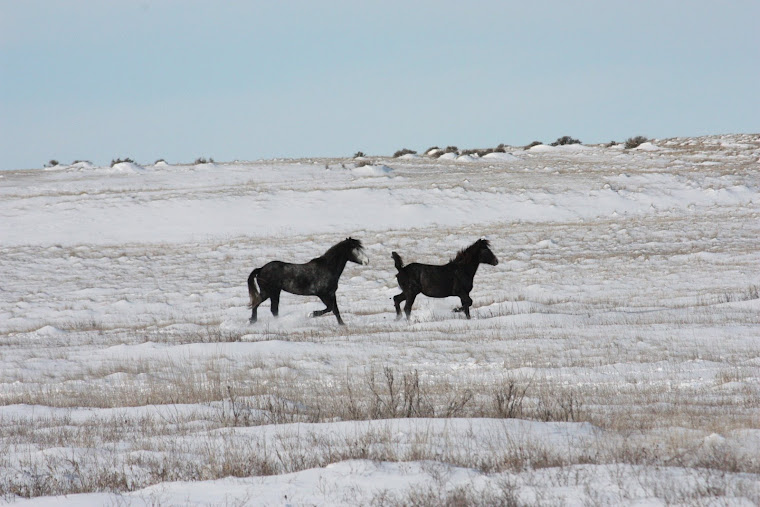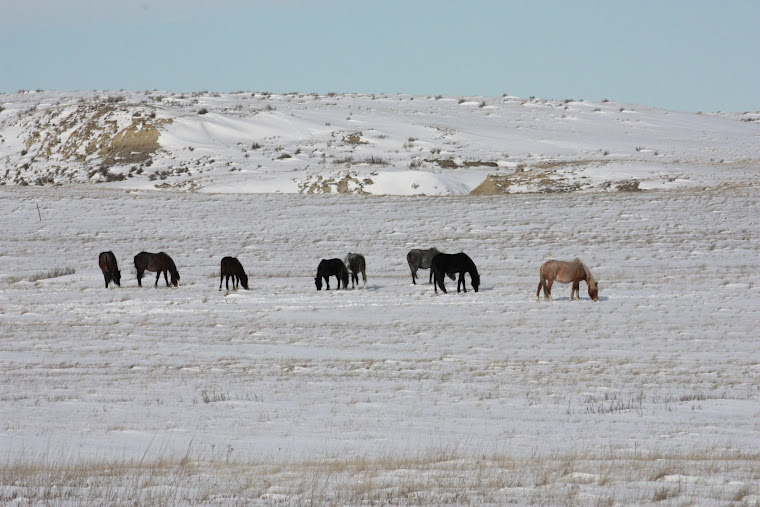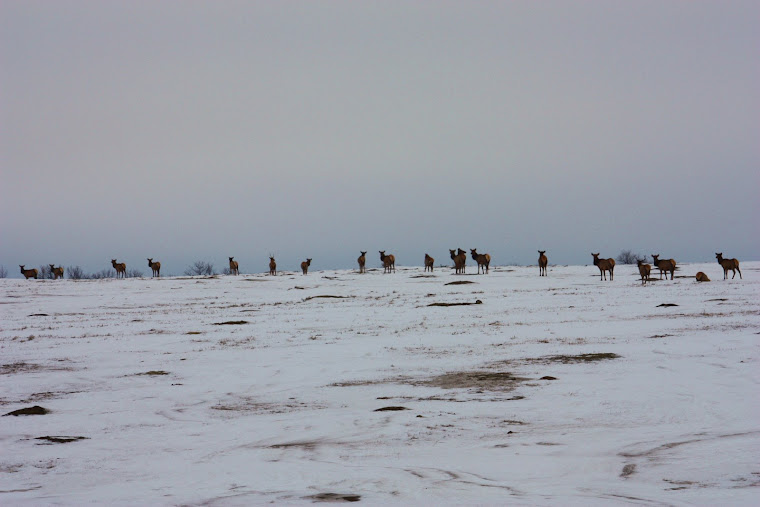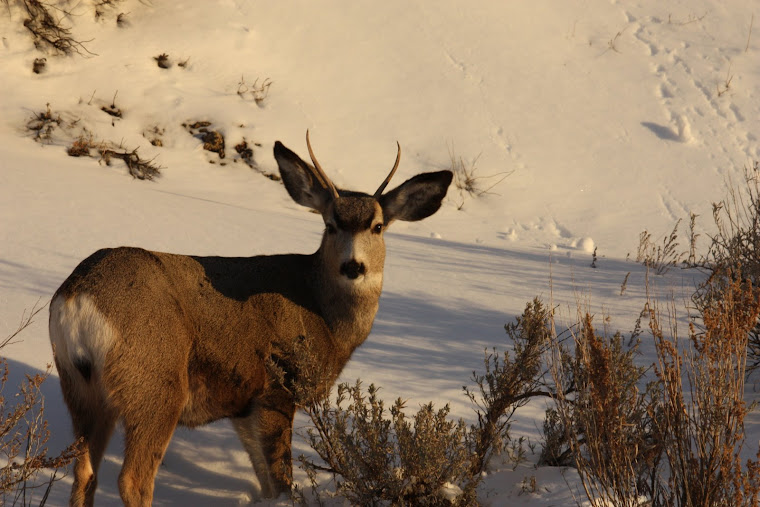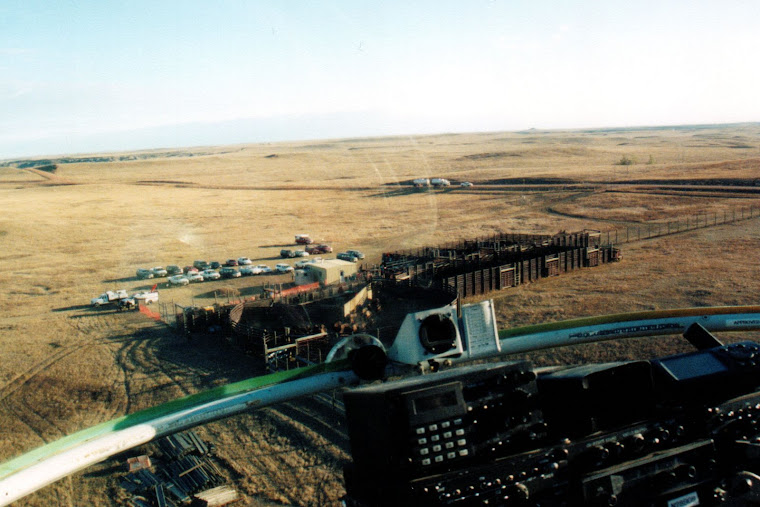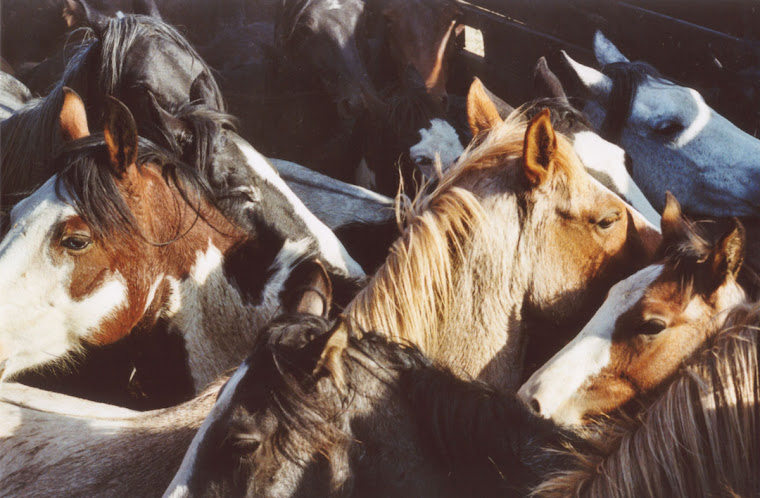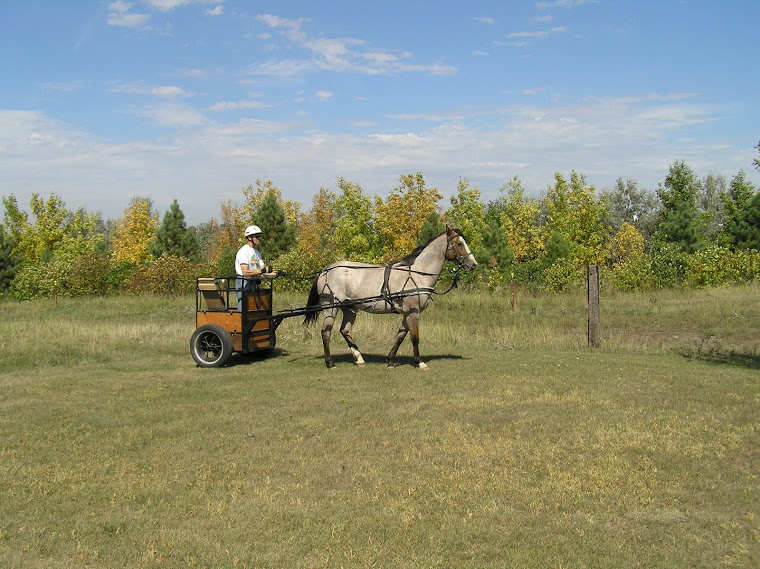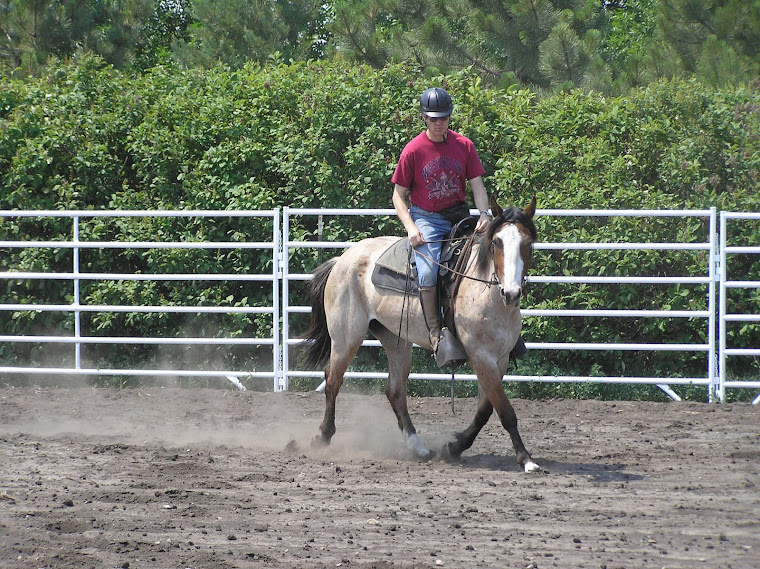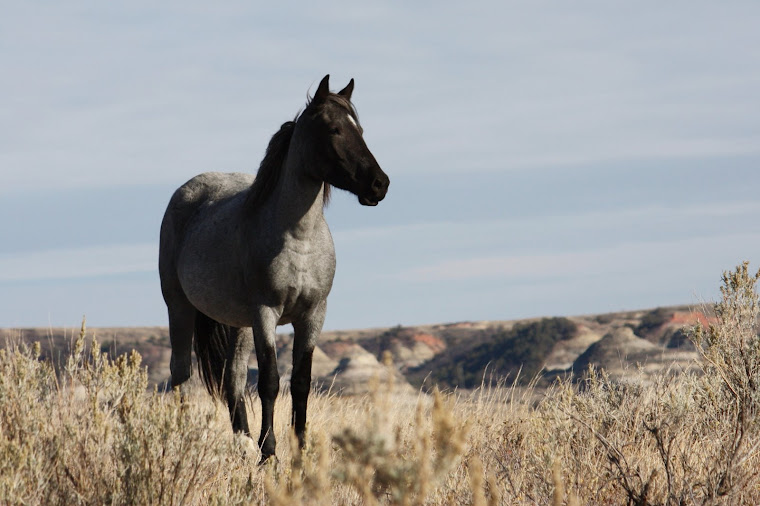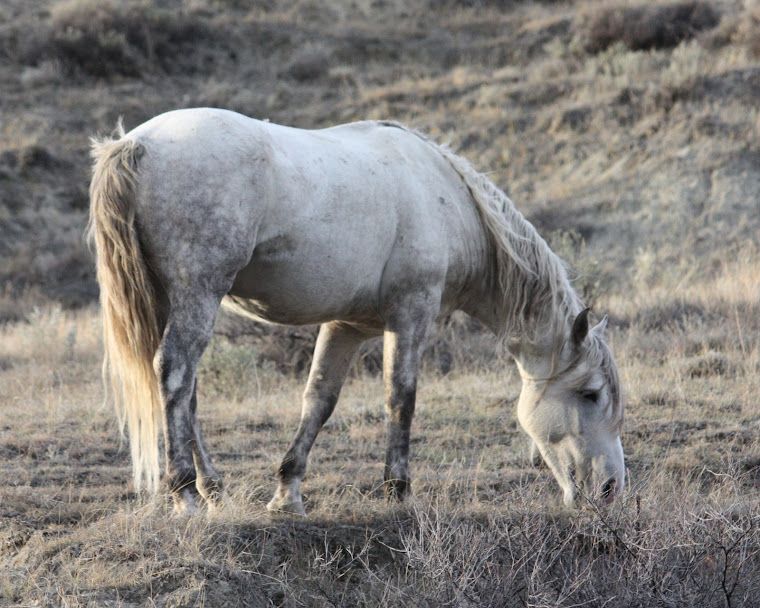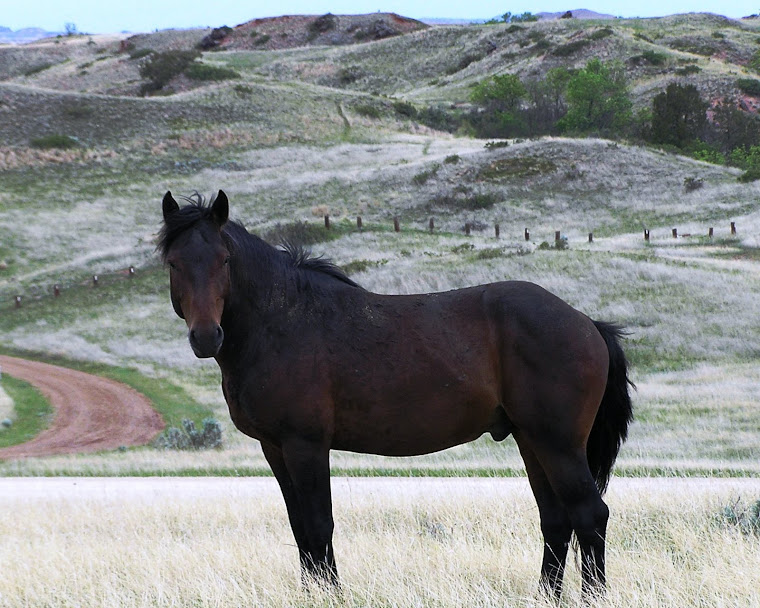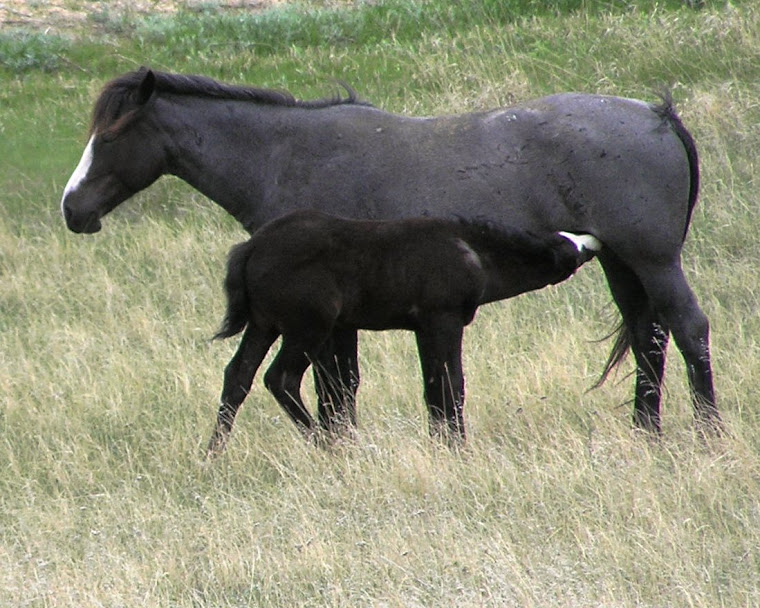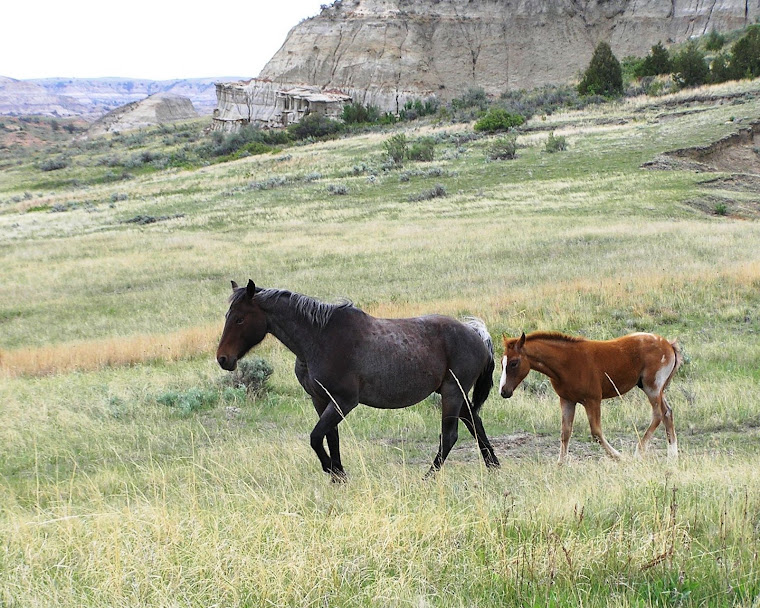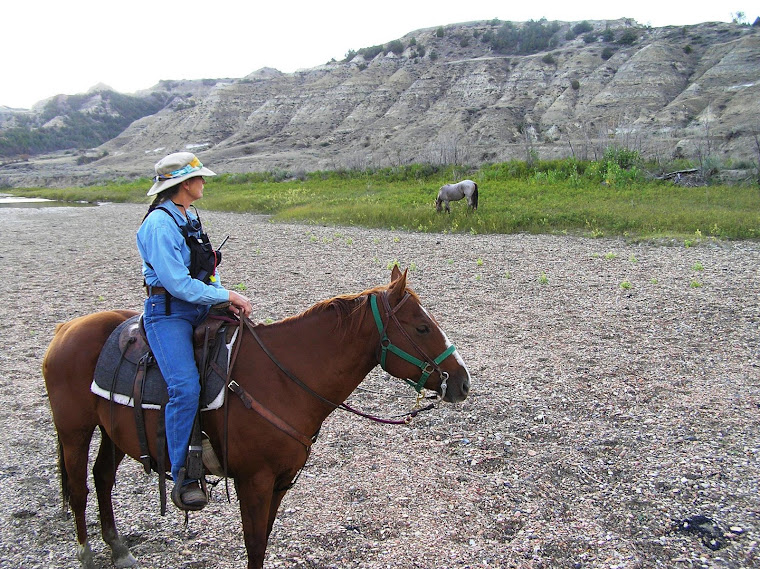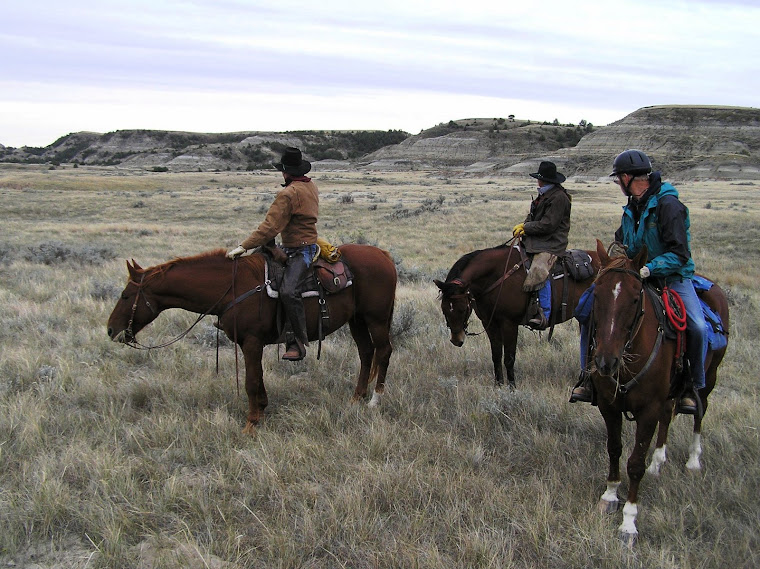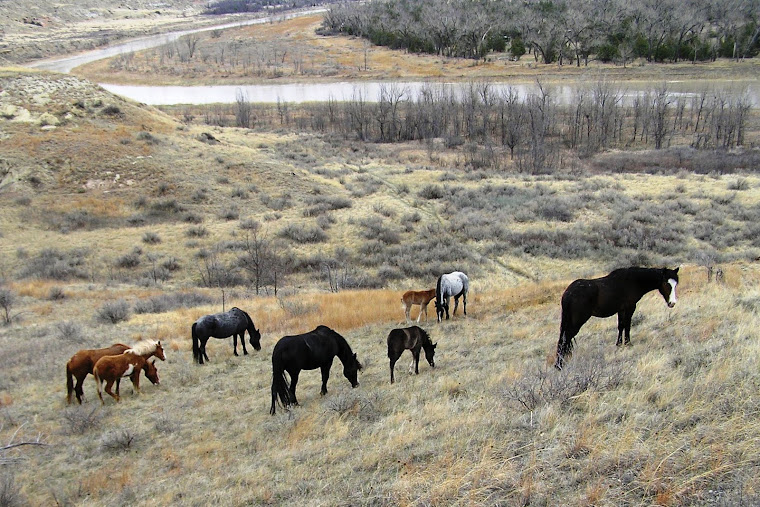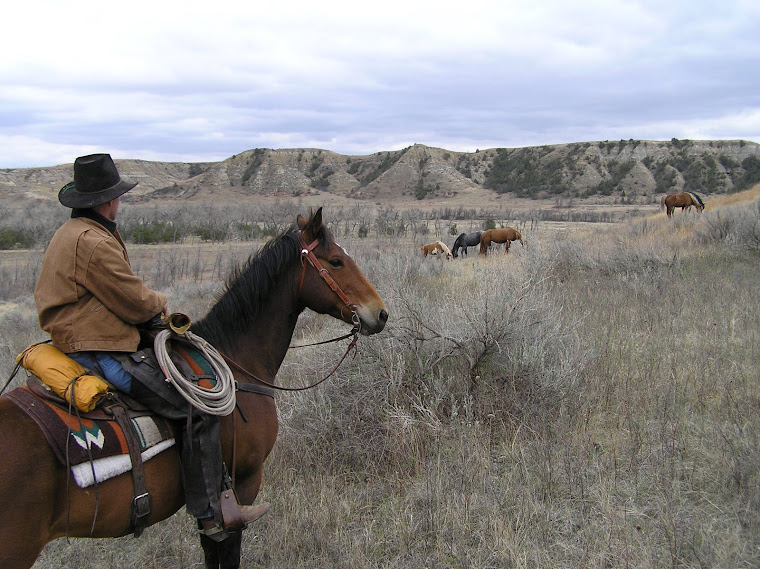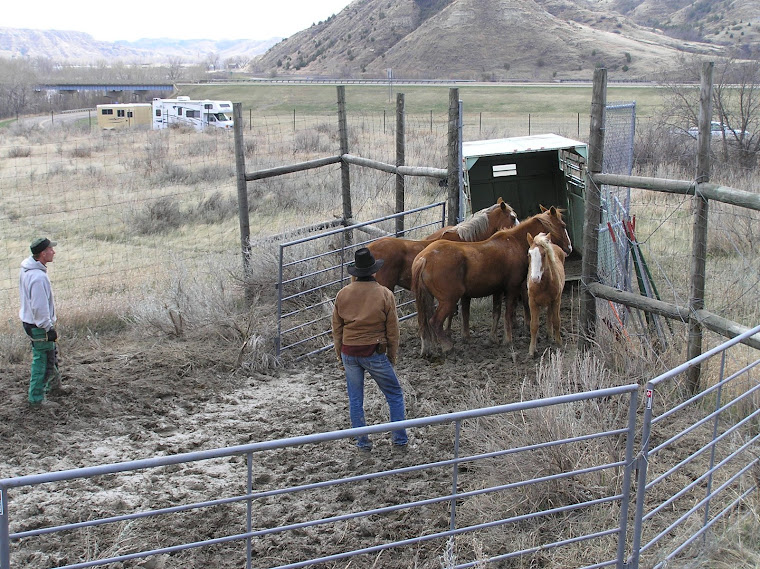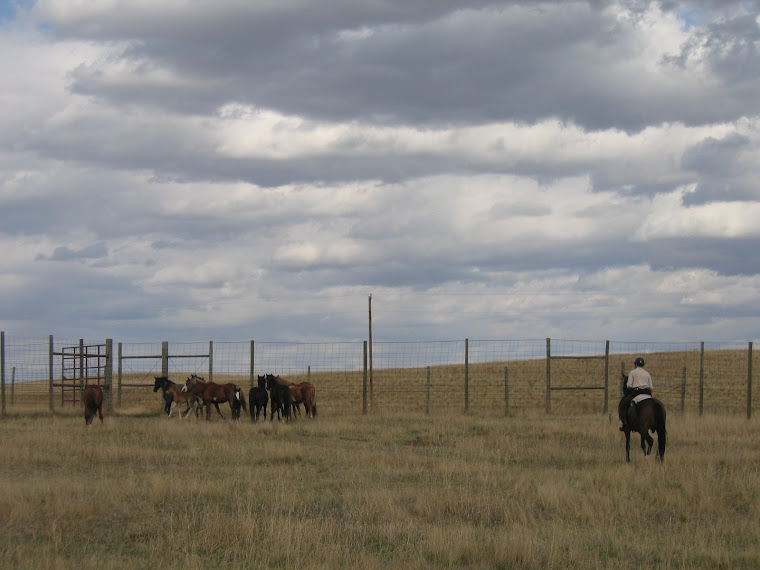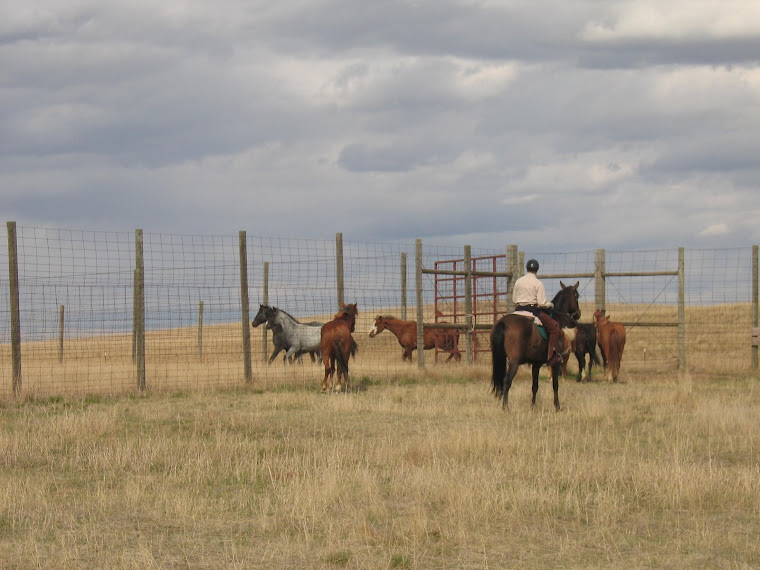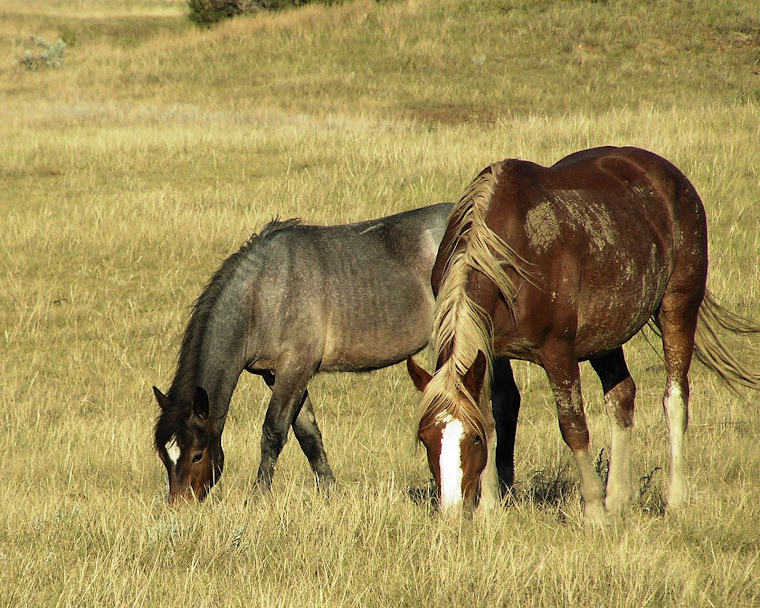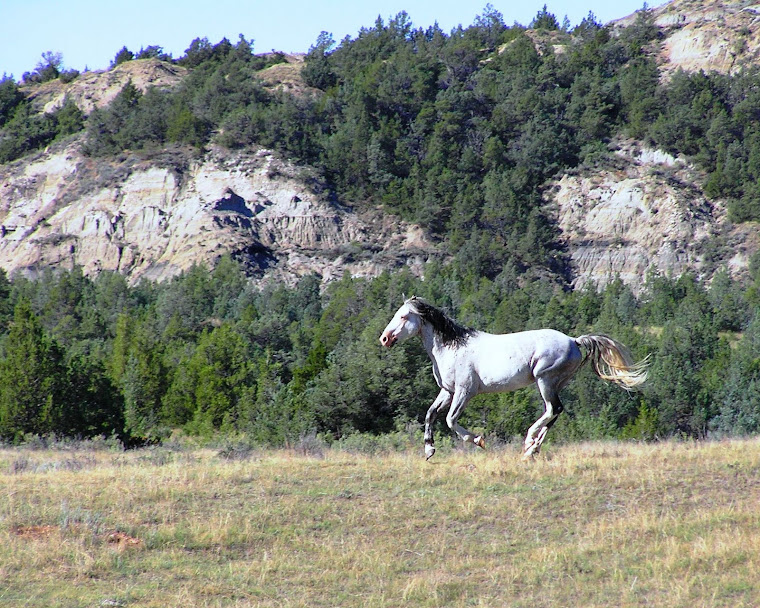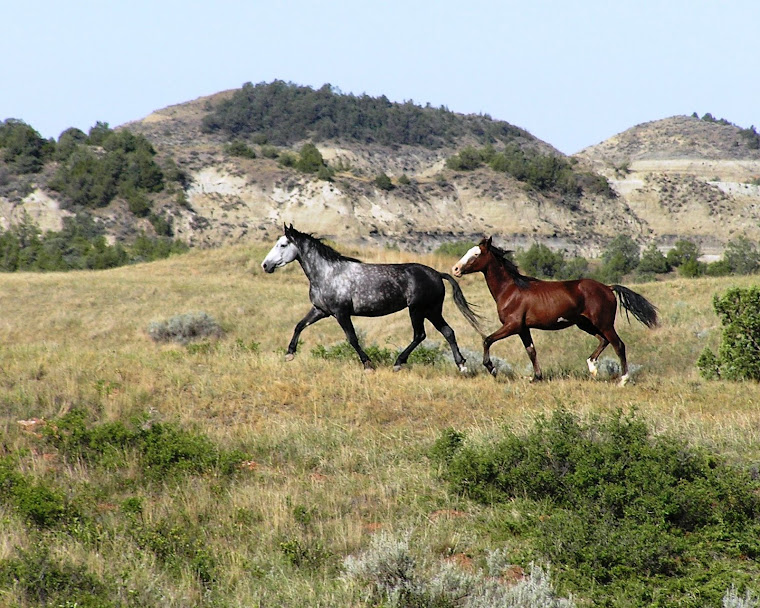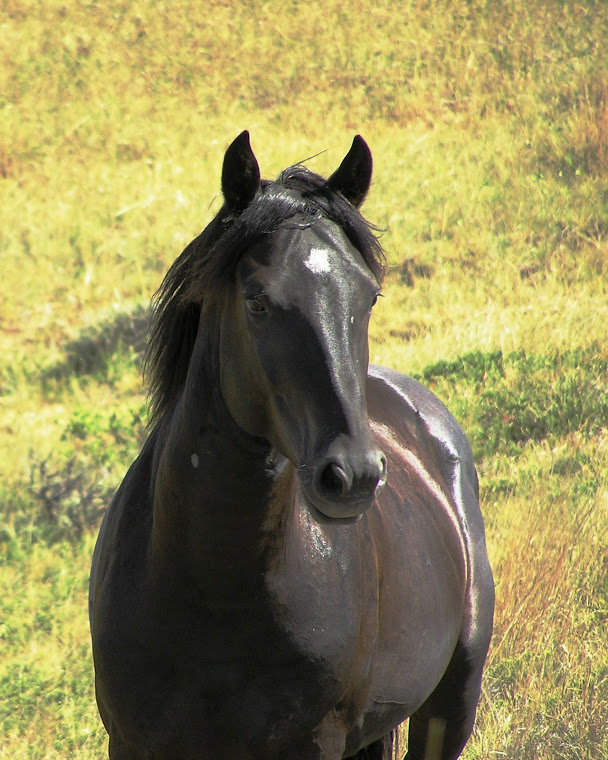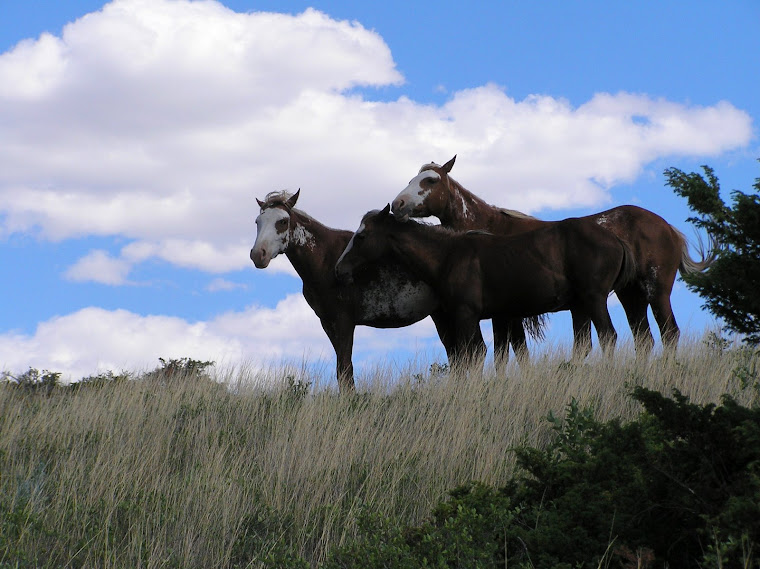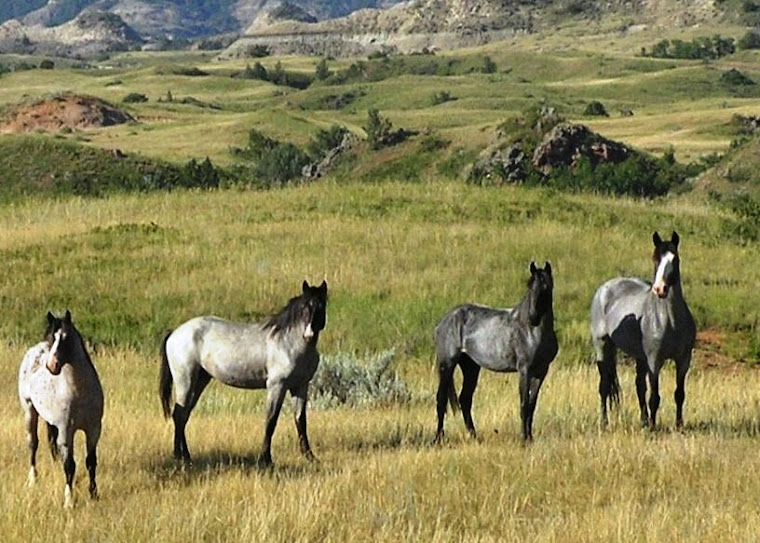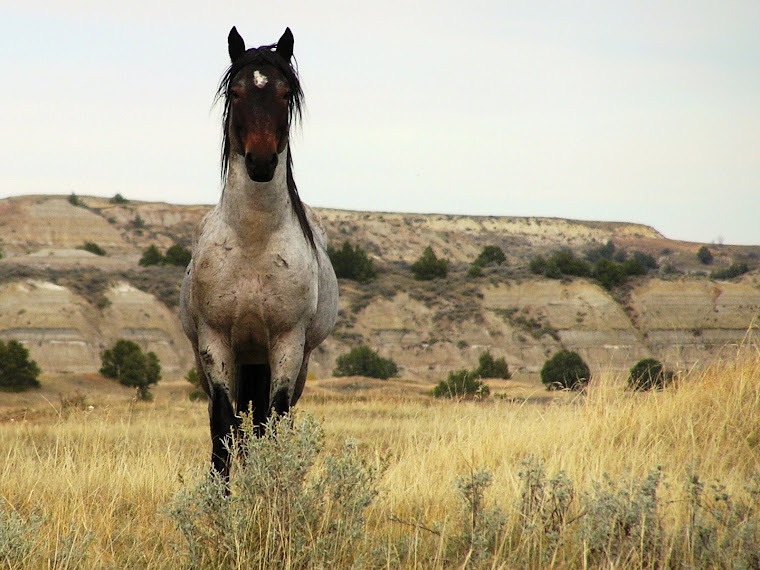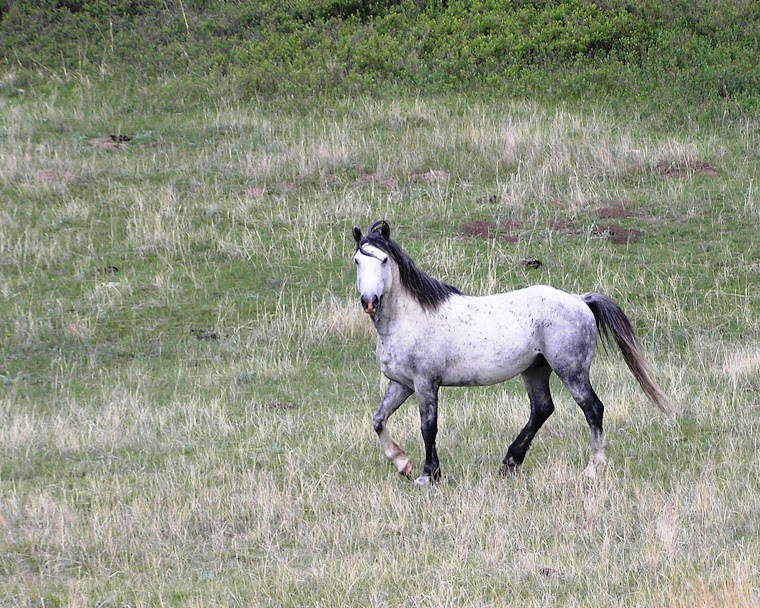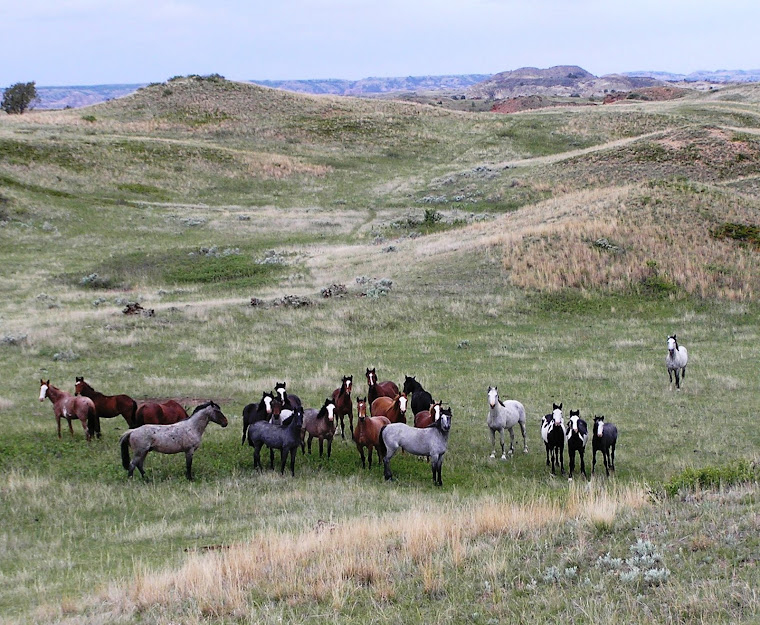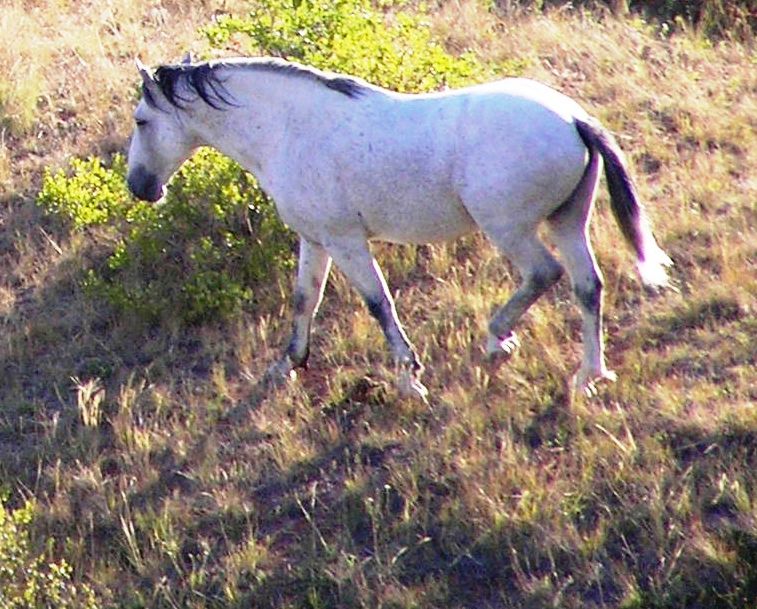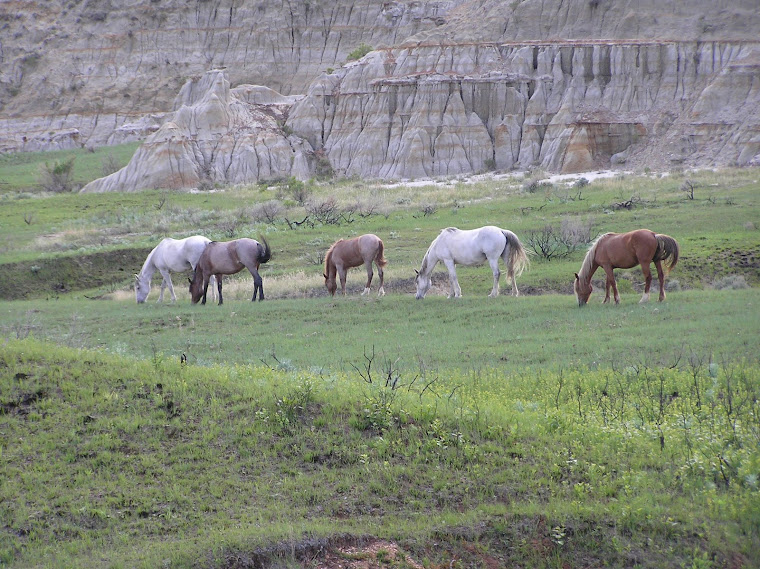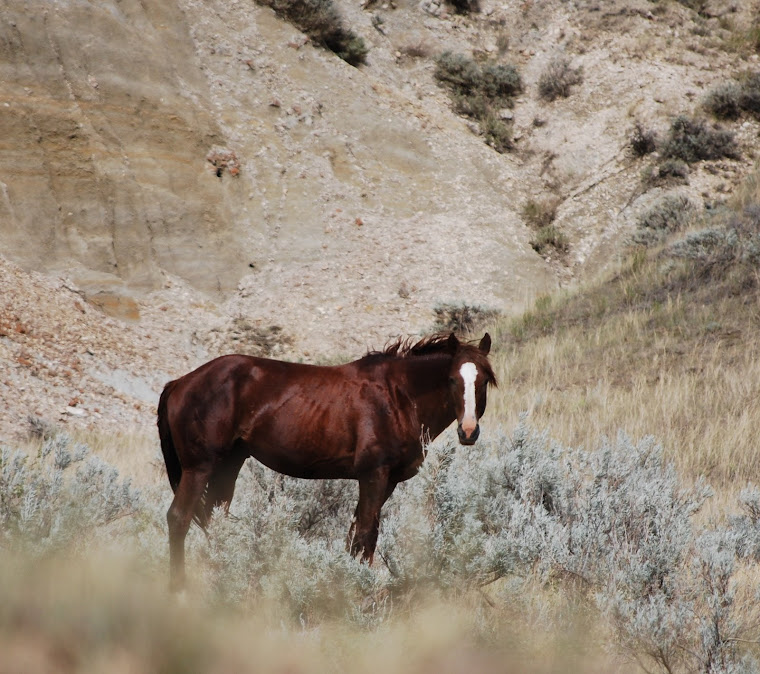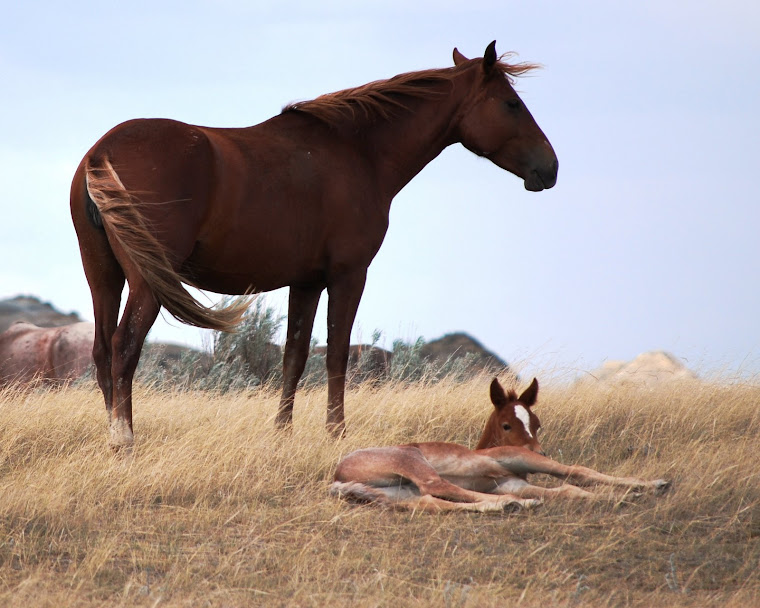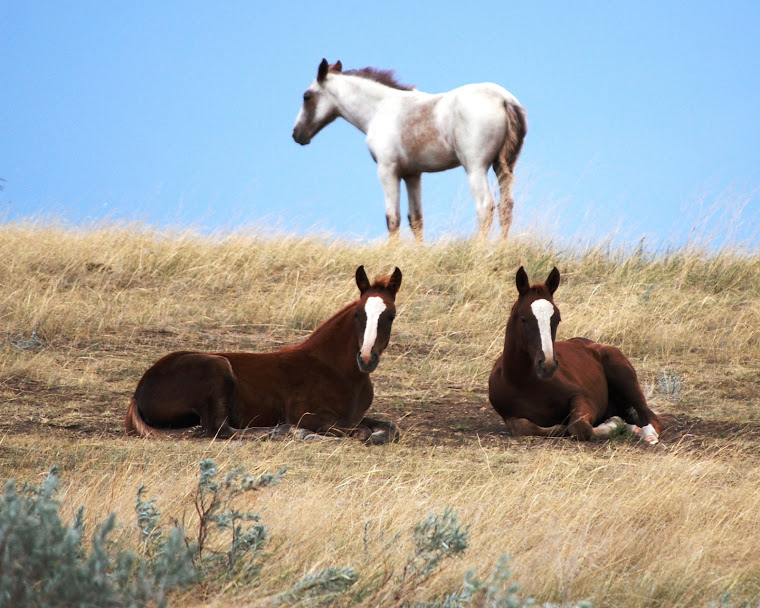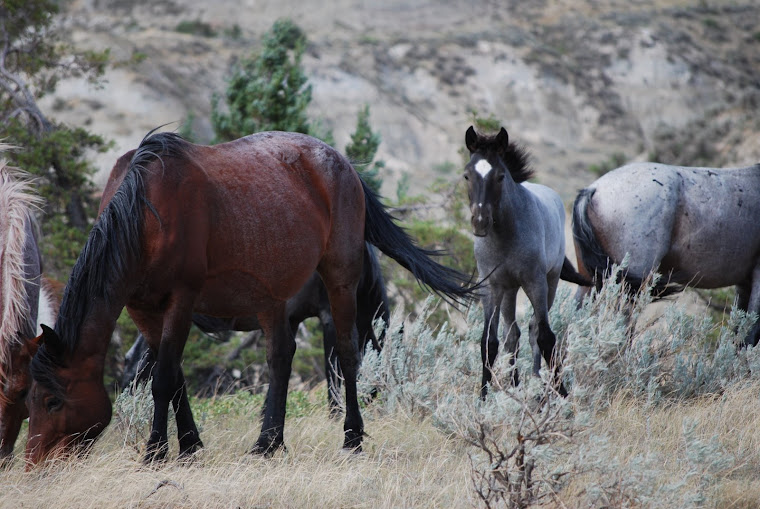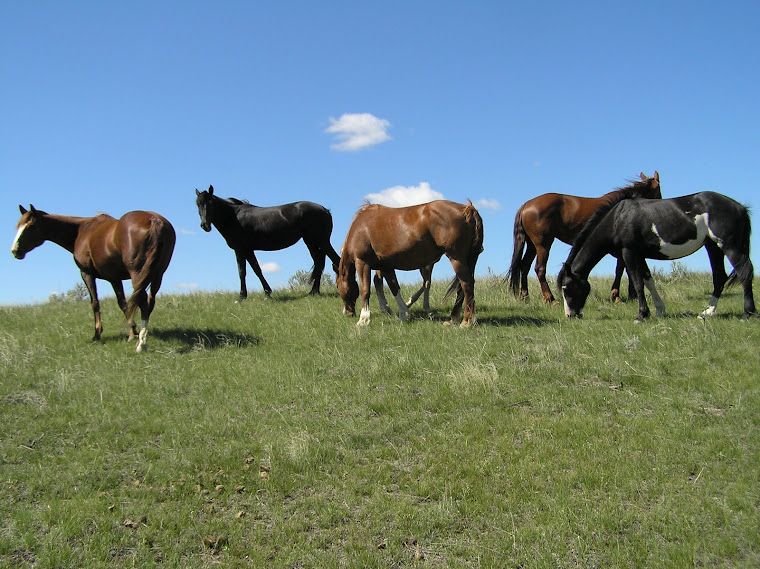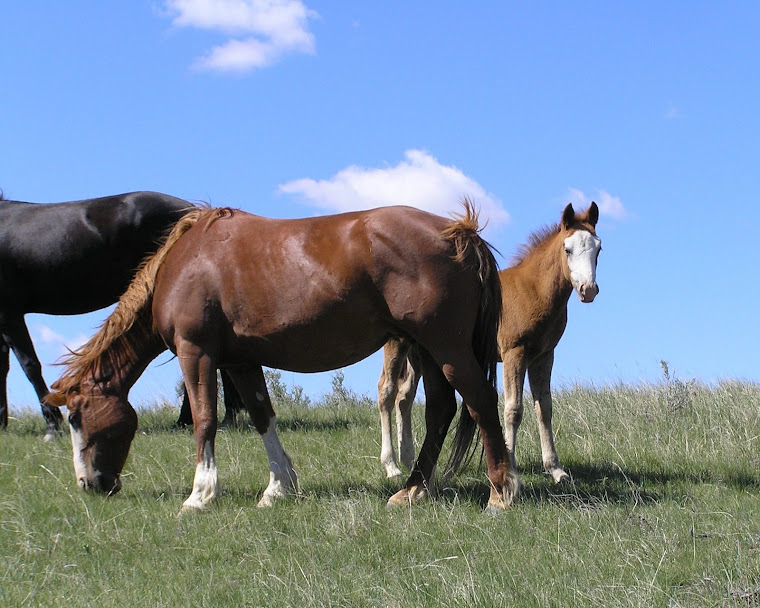I have finally finished a compilation of short stories, most of which are from this blog, but there are some new ones too. This project was done mostly for my family at the insistence of Sandi, my sister. A writer I am not, but she wanted me to record my stories of the adventures I have had while tracking the wild horses in TRNP over the past several years. Realizing I have had the privilege of doing what many people only dream of doing, spending time with wild horses running free in a wild, sometimes hazardous land, I am sharing this book with friends and others who may find it entertaining. I've had any family member I could coerce into helping me read through and proof it. Going over it a hundred times myself has only resulted in sore, tired eyes. Therefore, I hope there are no glaring mistakes in the book, but if there are, I don't want to know about them. The book is available for $29.95 in soft cover at Blurb at the following site. Eighty % of the profits for this book will go to North Dakota Badlands Horse, a 501 (c) (3) non profit established to promote and preserve the wild horses of TRNP. There is also a hard cover version available now. Thank you!
http://www.blurb.com/b/5874355-adventures-with-the-wild-horses-of-theodore-roosevelt-national-park
Tuesday, December 16, 2014
Wednesday, November 5, 2014
The 2015 Guide to the Wild Horses of Theodore Roosevelt National Park is now available for purchase on this site. It contains photos and brief descriptions of all the wild horses currently living in TRNP. It also has several pages intended to help you find a particular horse or know where to look for them. North Dakota Badlands Horse will be using sales of this guide as a fund raiser so that we can do more to promote these great horses. The Guide sells for $20/ea. + shipping. Thank you for your support of the horses and this project.
http://www.blurb.com/b/5707545-2015-guide-to-the-wild-horses-of-theodore-roosevelt-national-park
Saturday, August 16, 2014
BASHFUL, THE STEPS OF HIS LIFE by Marylu Weber
Spring of 2007, a dark colt opened his eyes for the first time, blinking at the sunshine streaming down on this land of buttes, juniper lined valleys, rock encrusted ridges, and grassy meadows. Theodore Roosevelt National Park had no meaning to him; this was just his world, his home, the place he would live out his life like all the other wild horses in his little band. Little did the blue colt know that his life would not be so simple, but for now he was intent on the only goal he must accomplish, standing up to nurse. His very first steps in life were pivotal in his survival. Stand and wobble on uncooperative legs to the sweet life-giving milk the pretty gray mare standing over him was patiently offering, or fall back to the ground, too weak to rise, succumb to the cold wind, and die. The dark colt took his first steps, reached his goal, drank in life, and grew in strength.
The first two weeks of a foal's life are tenuous with predators wanting to feed on their tender flesh and other stallions with flailing feet and biting teeth attempting to steal their dams during the foal heats. The land that provides shelter and nourishment to the band can be dangerous to foals running precariously on spindly legs through deep spring snow, hidden sink holes, and rocky gullies. Around 30% of newborn foals die in the first two weeks of life, but the blue colt was one of the lucky ones. With each day he grew stronger, soon adding bright green grass to his diet of milk.
Some time during his gestation, his dam, Winter, another cute red roan, maiden mare, Little Brother's Girl, and another gray mare, Rain, with her two fillies, were stolen from his sire, Thunder Cloud. Thunder Cloud had most likely been injured in the fight with Blaze, as he was now running with another bachelor, Copper, while he gained strength to fight again. The mares stayed several months with the feisty bay roan stud, Blaze, but by spring, his blue roan sire had gained enough strength to win them back. Unfortunately for the blue colt, at one year old, he was now also considered a threat and Thunder Cloud chased him away from the band before the blue colt could learn the ways of a wild stallion from his majestic sire.
The colt didn't have much choice but to join another young stallion who had been fiercely driven from his natal band. Though he was curious when he saw us, the two leggeds he would come upon on a regular basis, he was young and shy, and didn't want to get too close to us. He would hide behind the older, braver, bald faced colt. The bald faced black colt was a son of High Star out of the beautiful gray mare, Bella. His family had been taken by Embers, so he too needed company. We called the black, Baldy and the blue, Bashful, because of his shy behavior. It was already apparent that both would gray like their dams, though both had colored sires. They spent that summer and the next munching on the rich green grass and playing with other young stallions in the "bachelor" bands. The younger bachelors were often referred to as the "young guns" because they cruised the Park play fighting and looking for mischief. It was an idyllic life for a young horse; the valleys were filled with lush grass, water was abundant, and the young Bashful had not matured enough to worry about acquiring a band of his own. However, on a rainy day in October, life took another change for Bashful, forcing him to make another choice and another step into an unknown world
The helicopters hung low in the sky that day because of the overcast sky. As they came closer, the young stallions became frightened and started to run away from them. They could already see the forms of other horses moving away in the distance, up, out of the flats and onto Boicourt Ridge, then down again into Talkington valley. Though the helicopters were a constant reminder, looming behind with their rhythmic roaring, thumping like the heart in Bashful's chest, they didn't get too close, so the horses settled into a comfortable trot that was easy for the suckling foals who had joined them along with their dams. Most of the mares moved obediently up the trail toward the east ridge, not wanting to challenge the throbbing beasts above them. One pretty, light red roan mare, Pale Lady, was not to be intimidated; finding just the right gully to make her move, she suddenly broke from the herd and led her golden dun colt, Marquis, to safety. The pilots saw her go and one attempted to go after her, but not wanting to lose the others, they let her return to freedom. Along with several other wild horses, Bashful ran into the catch pen and into another chapter of his life.
The trip though the handling facility can be very frightening, but the Park people stayed quiet and as gentle as they could be to move the horses, one at a time, through the chutes. Bashful was so distracted by all the sights and sounds above the chute as he was weighed and measured that he barely felt the needle as Doc expertly drew blood for a Coggins test. All Bashful wanted was to get out of this tight spot; he hated being confined by the high solid walls and tried to focus on the blue sky ahead of him. It must have seemed like an eternity to him, but he was soon released to run down the ally to a large pen where his buddy, Baldy, was already munching on grass. They spent three days in the large wooden pen. The green grass soon turned to brown as their sharp hooves churned it into mud. They were given fresh hay, which was difficult to learn how to eat, but filled their nervous stomachs. Water was provided from a tank that they soon learned would not hurt them. They must have wondered what would happen next.
The horses destined for sale did not have long to wait; soon large trucks came and they were herded onto the noisy, smelly stock trailers. What was more frightening was the fact that they moved under the horses' feet. The rocking and bumping must have seemed to never end, but before long they were unloaded at the sales barn in Dickinson. Nothing could have prepared these wild horses for the noise and stress of sales day with hundreds of people flocking through the alleys to gaze at the horses and plan their purchases. Bashful was particularly nervous, as he hated confinement; his only comfort were his buddies in the pen with him. On October 23, 2009 Bashful made another step that would be pivotal to his survival.
Stepping into the sales ring itself, he moved around in a daze with all the noise and lights confusing him. He could see what seemed to be hundreds of the two legged creatures surrounding him and two in particular, flailing flags at him. He couldn't get his bearings; where were his buddies; where was the light leading him out of this chaos? Then he saw it, the light of day high above him. Bashful took a huge leap in order to reach the light, a jump like he had never attempted before, to take him away from this cacophony of sounds and pressure, away to freedom. He gathered his body, tucked his front legs under his chest, rocked back on his haunches, and pushed with all the power and adrenalin within him. Up he soared toward the light, but he didn't make it to freedom; the cruel cable fence caught his hind leg and he came crashing into the crowd of people. The people screamed with fright and Bashful screamed with pain as the cable slashed into his leg. He pawed and fought furiously to get free, but it was not to be. A man under him felt his fury; a vidiographer, Brad, put himself in jeopardy and reached in to pull the man to safety; another man, Dan, threw his jacket over Bashful's head to try to calm him, but Bashful was in too much pain and terror to be calmed. He fought the jacket and anything else in reach of his teeth until his blood left crimson stains where once enthusiastic buyers had been.
What would happen to Bashful now? How would they remove him from the cable fence? Not able to watch any more, I left my safe vantage point in the auctioneer's box. Sure that they would have to euthanize him to get him off the fence, I couldn't bear to see it. As people milled around outside the barn I wondered what Bashful's fate would be inside. As the ambulance rushed away with the injured man, I learned that Bashful was removed alive from the fence and was recovering from sedation far back in the lot, away from the crowd, away from the noise, away from the auctioneer's cry as he finished the sale in the back barn. I could hardly be happy for Bashful, since he had decided his fate when he took that leap. Injured and deemed a rogue, no one would want to take him home now.
At that instant, Michael Sparling, who I had known since he was a little kid, son of our good friends, a Parelli Professional trainer, came to me and said, "I want that horse!" I was a little taken aback and just said I didn't know if they would sell him right away but to go for it. When the decision was made to sell him, Michael stepped in and bought Bashful for $35. Michael had now made a step that would forever save Bashful from certain death. Michael had seen in him a challenge to turn a horse others had rejected into one others would one day admire. Since Michael was taking on a new job in Washington state and Bashful was too injured to travel, it was decided to leave him with Michael's dad, Dan, in Bismarck. Michael spent a little time, even one night, with Bashful before his job took him to Seattle. It must have been sad to leave the nervous, blue colt behind.
It happened that Dan was also a Parelli Natural Horsemanship trainer and, having wanted to buy one of the wild ones himself, he couldn't resist starting to see what he could do with Bashful. Since Bashful was injured and Dan had injured his foot, his first tactic was to just sit outside the pen. Little by little and with generous use of treats, Dan was able to win Bashful over. He broke goals down into simple steps Bashful could understand and rewarded him for the right reactions.
With Dan's patience he gained Bashful's trust to the point of giving every part of his body up to be petted and scratched. Like other TRNP horses removed that fall, Bashful had winter ticks and loved to be scratched where they had been feeding on him. This became a way to keep Bashful coming back for attention. The scratching led to playing confidence building games, which led to under saddle training.
Over the summer Bashful became more and more reliable as a saddle horse. October 22, 2010 Dan rode Bashful back into the park. Bashful stepped with confidence onto the sun flooded ground where he was born, into the juniper lined valleys, across the rock strewn ridges, up the high buttes, and down the grassy meadows. He is in Dan's "herd of two" now and his future is bright.
The first two weeks of a foal's life are tenuous with predators wanting to feed on their tender flesh and other stallions with flailing feet and biting teeth attempting to steal their dams during the foal heats. The land that provides shelter and nourishment to the band can be dangerous to foals running precariously on spindly legs through deep spring snow, hidden sink holes, and rocky gullies. Around 30% of newborn foals die in the first two weeks of life, but the blue colt was one of the lucky ones. With each day he grew stronger, soon adding bright green grass to his diet of milk.
Some time during his gestation, his dam, Winter, another cute red roan, maiden mare, Little Brother's Girl, and another gray mare, Rain, with her two fillies, were stolen from his sire, Thunder Cloud. Thunder Cloud had most likely been injured in the fight with Blaze, as he was now running with another bachelor, Copper, while he gained strength to fight again. The mares stayed several months with the feisty bay roan stud, Blaze, but by spring, his blue roan sire had gained enough strength to win them back. Unfortunately for the blue colt, at one year old, he was now also considered a threat and Thunder Cloud chased him away from the band before the blue colt could learn the ways of a wild stallion from his majestic sire.
The colt didn't have much choice but to join another young stallion who had been fiercely driven from his natal band. Though he was curious when he saw us, the two leggeds he would come upon on a regular basis, he was young and shy, and didn't want to get too close to us. He would hide behind the older, braver, bald faced colt. The bald faced black colt was a son of High Star out of the beautiful gray mare, Bella. His family had been taken by Embers, so he too needed company. We called the black, Baldy and the blue, Bashful, because of his shy behavior. It was already apparent that both would gray like their dams, though both had colored sires. They spent that summer and the next munching on the rich green grass and playing with other young stallions in the "bachelor" bands. The younger bachelors were often referred to as the "young guns" because they cruised the Park play fighting and looking for mischief. It was an idyllic life for a young horse; the valleys were filled with lush grass, water was abundant, and the young Bashful had not matured enough to worry about acquiring a band of his own. However, on a rainy day in October, life took another change for Bashful, forcing him to make another choice and another step into an unknown world
The helicopters hung low in the sky that day because of the overcast sky. As they came closer, the young stallions became frightened and started to run away from them. They could already see the forms of other horses moving away in the distance, up, out of the flats and onto Boicourt Ridge, then down again into Talkington valley. Though the helicopters were a constant reminder, looming behind with their rhythmic roaring, thumping like the heart in Bashful's chest, they didn't get too close, so the horses settled into a comfortable trot that was easy for the suckling foals who had joined them along with their dams. Most of the mares moved obediently up the trail toward the east ridge, not wanting to challenge the throbbing beasts above them. One pretty, light red roan mare, Pale Lady, was not to be intimidated; finding just the right gully to make her move, she suddenly broke from the herd and led her golden dun colt, Marquis, to safety. The pilots saw her go and one attempted to go after her, but not wanting to lose the others, they let her return to freedom. Along with several other wild horses, Bashful ran into the catch pen and into another chapter of his life.
The trip though the handling facility can be very frightening, but the Park people stayed quiet and as gentle as they could be to move the horses, one at a time, through the chutes. Bashful was so distracted by all the sights and sounds above the chute as he was weighed and measured that he barely felt the needle as Doc expertly drew blood for a Coggins test. All Bashful wanted was to get out of this tight spot; he hated being confined by the high solid walls and tried to focus on the blue sky ahead of him. It must have seemed like an eternity to him, but he was soon released to run down the ally to a large pen where his buddy, Baldy, was already munching on grass. They spent three days in the large wooden pen. The green grass soon turned to brown as their sharp hooves churned it into mud. They were given fresh hay, which was difficult to learn how to eat, but filled their nervous stomachs. Water was provided from a tank that they soon learned would not hurt them. They must have wondered what would happen next.
The horses destined for sale did not have long to wait; soon large trucks came and they were herded onto the noisy, smelly stock trailers. What was more frightening was the fact that they moved under the horses' feet. The rocking and bumping must have seemed to never end, but before long they were unloaded at the sales barn in Dickinson. Nothing could have prepared these wild horses for the noise and stress of sales day with hundreds of people flocking through the alleys to gaze at the horses and plan their purchases. Bashful was particularly nervous, as he hated confinement; his only comfort were his buddies in the pen with him. On October 23, 2009 Bashful made another step that would be pivotal to his survival.
Stepping into the sales ring itself, he moved around in a daze with all the noise and lights confusing him. He could see what seemed to be hundreds of the two legged creatures surrounding him and two in particular, flailing flags at him. He couldn't get his bearings; where were his buddies; where was the light leading him out of this chaos? Then he saw it, the light of day high above him. Bashful took a huge leap in order to reach the light, a jump like he had never attempted before, to take him away from this cacophony of sounds and pressure, away to freedom. He gathered his body, tucked his front legs under his chest, rocked back on his haunches, and pushed with all the power and adrenalin within him. Up he soared toward the light, but he didn't make it to freedom; the cruel cable fence caught his hind leg and he came crashing into the crowd of people. The people screamed with fright and Bashful screamed with pain as the cable slashed into his leg. He pawed and fought furiously to get free, but it was not to be. A man under him felt his fury; a vidiographer, Brad, put himself in jeopardy and reached in to pull the man to safety; another man, Dan, threw his jacket over Bashful's head to try to calm him, but Bashful was in too much pain and terror to be calmed. He fought the jacket and anything else in reach of his teeth until his blood left crimson stains where once enthusiastic buyers had been.
What would happen to Bashful now? How would they remove him from the cable fence? Not able to watch any more, I left my safe vantage point in the auctioneer's box. Sure that they would have to euthanize him to get him off the fence, I couldn't bear to see it. As people milled around outside the barn I wondered what Bashful's fate would be inside. As the ambulance rushed away with the injured man, I learned that Bashful was removed alive from the fence and was recovering from sedation far back in the lot, away from the crowd, away from the noise, away from the auctioneer's cry as he finished the sale in the back barn. I could hardly be happy for Bashful, since he had decided his fate when he took that leap. Injured and deemed a rogue, no one would want to take him home now.
At that instant, Michael Sparling, who I had known since he was a little kid, son of our good friends, a Parelli Professional trainer, came to me and said, "I want that horse!" I was a little taken aback and just said I didn't know if they would sell him right away but to go for it. When the decision was made to sell him, Michael stepped in and bought Bashful for $35. Michael had now made a step that would forever save Bashful from certain death. Michael had seen in him a challenge to turn a horse others had rejected into one others would one day admire. Since Michael was taking on a new job in Washington state and Bashful was too injured to travel, it was decided to leave him with Michael's dad, Dan, in Bismarck. Michael spent a little time, even one night, with Bashful before his job took him to Seattle. It must have been sad to leave the nervous, blue colt behind.
It happened that Dan was also a Parelli Natural Horsemanship trainer and, having wanted to buy one of the wild ones himself, he couldn't resist starting to see what he could do with Bashful. Since Bashful was injured and Dan had injured his foot, his first tactic was to just sit outside the pen. Little by little and with generous use of treats, Dan was able to win Bashful over. He broke goals down into simple steps Bashful could understand and rewarded him for the right reactions.
With Dan's patience he gained Bashful's trust to the point of giving every part of his body up to be petted and scratched. Like other TRNP horses removed that fall, Bashful had winter ticks and loved to be scratched where they had been feeding on him. This became a way to keep Bashful coming back for attention. The scratching led to playing confidence building games, which led to under saddle training.
Over the summer Bashful became more and more reliable as a saddle horse. October 22, 2010 Dan rode Bashful back into the park. Bashful stepped with confidence onto the sun flooded ground where he was born, into the juniper lined valleys, across the rock strewn ridges, up the high buttes, and down the grassy meadows. He is in Dan's "herd of two" now and his future is bright.
 |
| Dan on Bashful at the 2013 Reunion Ride SCROLL TO THE BOTTOM OF THIS PAGE TO SEE MORE PHOTOS OF BASHFUL AS A FOAL AND HIS FIRST STEP BACK INTO THE PARK WITH DAN. |
Wednesday, August 13, 2014
SAGE AND PEACE PIPE by Marylu Weber
After seeing the horses housed at the Sieben Live Stock headquarters, we climbed into the vehicles for the short drive to the corrals where the four once wild horses had been when they escaped for the winter. Sage, the gray overo, and his older gray brother, Peace Pipe, were the only animals there at this time. Iain sent the two into the high round pen from their corral. Whit mentioned that when it was been built he thought the round pen was higher than necessary, but with the 3 and 4 year old wild horses, it didn't seem too high; the horses never looked to jump its rail sides. Cutting Peace Pipe back into the corral, Iain started to work with young Sage.
Each horse needs to be treated as an individual so none of the horses can be expected to react the same to each step of their training, but carefully and patiently the young men will win the trust and devotion of the horses. In training a horse there must be as much joy and appreciation of the journey as there is in the end result. Realistically horse training is more about the journey because horse training is never finished; there is always more to learn and each time one is in the presence of a horse, both horse and human are learning. The goal is to teach positive partnership so that both grow. Sage and Peace Pipe will grow and learn as they develop trust in the people around them.
With a braided rope called a reata in one hand, Iain sent Sage around the pen at a lofty trot. There was no need to wear him down; Iain was just allowing Sage to move freely and decide for himself when he wanted to stop. When Sage stopped, Iain would immediately stop, releasing the pressure rewarding him so that Sage soon learned that stopping and standing still was what Iain expected. That lesson learned, Iain went on to roping Sage by the neck and then by a front foot. Sage was still a long way from leading readily, but he was getting the idea that he should yield to the pressure of the rope. Now when he yielded to the pressure, Sage would get a gentle stroking on his face, neck, and shoulders. After haltering him, Iain asked Sage to yield his hind and then his front quarters, teaching him to turn away from the pressure of the scary bag on the end of the stick which was the beginning of what would later be control of the front and hind quarters in order to move obediently to the cowboy’s cues. Iain ended the session with Sage’s acceptance of the saddle pad. It is always better to stop when positive acceptance has been achieved. The saddle would come another day. Sage had already been saddled so he was well on his way to the day he would be ridden. The most important lesson of the day was that Sage could trust Iain not to hurt him. As that trust is gained the horse begins to yield his whole body and spirit to the soft hands of the cowboy.
.JPG) |
| Sage wants to engage with Iain |
.JPG) |
| Sage is rewarded with a soft rub on the nose. |
 |
| By his actions, it is very apparent that Sage in interested in this cowboy. |
.JPG) |
| The bond of friendship is being built both ways; horse and man benefit from this understanding. |
 |
| Iain uses the rope to get Sage used to being touched with foreign objects. |
 |
| The saddle pad is not frightening to Sage. |
.JPG) |
| Sage learns to move at the direction of his handler. |
 |
| Iain with his two young children |
.JPG) |
| Cooper Hibbard |
All the while Iain was working with Sage, Cooper had been watching and gleaning every tidbit of information from what he had just witnessed. Cooper is, himself, an accomplished horseman though shy about working in front of an audience. Letting Sage out of the pen and bringing Peace Pipe in, Cooper started to build a relationship with the frightened horse. Peace Pipe was much more nervous than Sage had been so his trot around the pen was more animated, giving everyone watching a thrill at the power and suspension of his extended trot. As nervous as he was, Peace Pipe soon learned, by pressure and release that he should move, stop, turn, and face up by the cues Cooper gave him though body language. After working with Peace Pipe a few minutes at liberty, Cooper too roped Peace Pipe to teach him that it would not hurt him and that it was a way for Cooper to communicate with him. Once the rope was around Peace Pipe’s neck, he was surprisingly soft to it, letting himself be encouraged around the pen with a soft feel. He accepted the soft strokes of Cooper’s hands and the feel of the coiled rope rubbed on his body, but he was still tense, ready to bolt at any moment that the pressure became too much for him. Cooper wanted him to accept his touch equally on both sides of his body. What is done on one side of a horse must be done on the other because each eye works individually when watching for danger and needs to be acclimated to the hands and the equipment of the cowboy. Working quietly, changing from one eye to the other, Cooper soothed the tense gelding with quiet hands and calm movement. Peace Pipe was not ready to accept the halter or saddle pad yet; that would have to come another day, but Peace Pipe learned too that the young cowboy at the other end of the rope was not going to hurt him.
 |
| This wasn't even Peace Pipe's biggest trot, but he is completely suspended above the ground. |
.JPG) |
| Peace Pipe wants to engage with Cooper, but he is more wary than his younger brother, Sage. |
.JPG) |
| Peace Pipe is rewarded with a face rub. |
.JPG) |
| Cooper was working on getting Peace Pipe to allow him on both sides equally. |
.JPG) |
| Peace Pipe was not so sure he wanted Cooper on his left side. |
.JPG) |
| Notice the softness in Cooper and the slack rope. |
Each horse needs to be treated as an individual so none of the horses can be expected to react the same to each step of their training, but carefully and patiently the young men will win the trust and devotion of the horses. In training a horse there must be as much joy and appreciation of the journey as there is in the end result. Realistically horse training is more about the journey because horse training is never finished; there is always more to learn and each time one is in the presence of a horse, both horse and human are learning. The goal is to teach positive partnership so that both grow. Sage and Peace Pipe will grow and learn as they develop trust in the people around them.
Friday, August 8, 2014
Thursday, August 7, 2014
TOMAHAWK AND HAWTHORNE
 |
| Felice, Deb, Iain, Whit, Cooper, Henry, Bob, Iain's two children, and Whit and Felice's dog |
 |
| Deb and Felice |
 |
| Whit and Iain talking business |
 |
| Deb and Hawthorne |
.JPG) |
| Bob and Hawthorne |
 |
| Bryce and Hawthorne |
 |
| Tomahawk |
By Marylu Weber
Spring had finally come to the sprawling Sieben Live Stock
Co. ranch. Bright green blades of rich
grass were pushing through the soil of the mountain meadows, seeking the warmth
of the sun. It would soon be time to
move cattle to summer pastures higher in the mountains and prepare for the
arrival of new calves. The registered ewes,
the last remnant of the vast herds of sheep that used to roam the ranch, would also
soon be lambing. Saddle horses would be
needed for all the spring and summer chores, so they were brought in from
winter pastures, hooves trimmed, and shoes nailed on.
Warmer weather and good footing would make it easier to work
with the four young blue geldings that still needed to be gentled and trained
under saddle. Time was limited but the
cowboys would do the best they could.
Brent, who was to work with Peace Pipe, had moved on the find a home
more accessible to schooling for his children, so Cooper would take on Peace
Pipe and Bryce, with Iain’s help, would work with both Tomahawk, the
challenging one, and Hawthorne, the friendly one.
Deb, Bob, Henry, and I had planned for several months to
visit the ranch, meet the cowboys, and see the horses again. That sunny July morning as we drove the long
gravel road to the ranch, we could hardly contain our excitement. The scenery was beautiful as lush green
pastures laced with small tree lined creeks gave way to rolling hills,
evergreen strewn mountains, and rocky crags.
Upon arrival we immediately met a young man dressed for
ranch work in jeans, chambray shirt, and white cowboy hat, who came to us with
his hand outstretched for firm handshakes all around. This was Whit Hibbard’s nephew, Cooper
Hibbard, the one I had talked to on the phone and bought the horses for. He was the man who would one day take over
the vast Sieben Live Stock Company. We
could tell right away why he would be great at the work as he was thoughtful
and intelligent, polite, yet very confident.
He immediately began to tell us about the plans they had to sell grass
fed beef directly to companies that care about the quality of the beef they
use. We could have spent the morning
listening to him relate the progressive work they do on the ranch, but there
were others to meet. Whit, whom we had
known for years, was there with his new wife, Felice. We loved her immediately with her genuine
friendliness and knowledge of horses.
Some people are easy to figure out, and this beautiful woman was exactly
who she appeared to be. We were so happy
for Whit; Felice was a perfect match for him.
Another young man, dressed in similar manner as Cooper, came
with two of his adorable children. Again
there was the welcoming handshake of an authentic man, used to working with his
hands. But these men are not what one might expect of
a cowboy; these men, like Whit, are well educated, thoughtful men who chose the
lifestyle of a cowboy, not because it is all they have ever known, but because
there is no better life to be found than working with horses and cattle where
one can breathe clean air and trust another man by his word and his handshake. This young
family man was Iain, one of the cowboys we had corresponded with before coming
to the ranch. He too was quiet and
polite, but sure of himself and his ability.
They were all anxious to show us the ranch that was their home and the
horses that would one day be their partners.
The first horses we saw were in a large corral right there
at the headquarters. There were around
20 horses of various ages, mostly bay and sorrel Quarter horses, but two horses
stood out, mainly for their color; they were the gray, Tomahawk and the blue,
Hawthorne. We spread out in the pen to
scratch horses, and talk to Cooper, Whit, Felice, and Iain about the horses and
the ranch. Deb and Bob both loved on
Hawthorne while I snapped pictures. Hawthorne
was very approachable as long as one was careful to take time to let him know
there was nothing to fear. He seemed to
genuinely want the attention of the humans.
Tomahawk was much more timid. He
was OK with having us near, but not too near.
His comfort zone was about 20 ft. away from any human.
Later in the day, when we were able to meet Bryce, also an
engaging, kind, intelligent young man, he told us what he had been doing with
the two young horses. The men used the
round pens to get the horses used to facing up to a human. As expected Hawthorne was easy to get faced
up and easier to touch. They use a whip
with a bag on the end of it as an extension of their arm, to acclimate the
horse to strange touches and noises, and to encourage the horse to move. The first thing to teach the horse is that
the human can make him move his feet, establishing leadership. Since a horse is a herd animal and a prey
animal, he looks for a leader who will keep him safe. Once he knows that the human is his leader,
he begins to depend on that leader for safety and direction. Both horses had been worked in the round pen,
roped around the neck and each foot to get them used to the touch of the rope
and to teach them to give to pressure so that they can one day be led and
tied. Both horses were OK with the rope
and the flag, but Tomahawk would take much longer to allow himself to be
touched by the “paws” of the predator, man.
Hawthorne had been saddled and had no problems with it so his education
could progress much like that of a domestic horse, but Bryce so longed for the
day that he could saddle up the strong handsome Tomahawk and ride him out to
work cattle. Well, he would have to bide
his time and patiently let Tomahawk set the pace of his own education. One day we will visit again and see the
progress made with the once wild horses of the Sieben ranch.
Thursday, July 31, 2014
From L to R are Bonnie and Sugar, Dan and Bashful, Whit and Teddy, Kristin and Baldy, Henry and Fire, Marylu and Hawk, Mya and Hail, and Bob and Crow. These horses were all born in the park.
The 2nd Annual Reunion Ride will be based out of Sully Creek State Park just south of Medora, ND, September 5-7. Come join us for trail rides in the park and other activities. You don't need to be riding a North Dakota Badlands Horse, you don't even need a horse. Just come and meet others who love the horses from Theodore Roosevelt National Park. Go to the Facebook page: North Dakota Badlands Horse for more information. Be sure to sign up for the event on that page.
The 2nd Annual Reunion Ride will be based out of Sully Creek State Park just south of Medora, ND, September 5-7. Come join us for trail rides in the park and other activities. You don't need to be riding a North Dakota Badlands Horse, you don't even need a horse. Just come and meet others who love the horses from Theodore Roosevelt National Park. Go to the Facebook page: North Dakota Badlands Horse for more information. Be sure to sign up for the event on that page.
Sunday, July 27, 2014
THE GREAT ESCAPE
 |
| Tracking in the snow |
The Sieben Four Adventure
By Marylu Weber
At one mile
above sea-level, winter comes early to the Sieben Live Stock Company ranch
nestled in the foothills of the Big Belt Mountains of Montana. The four wild young stallions that had been
purchased from Theodore Roosevelt National Park had been gelded and kept
together in a large corral separated from the ranch headquarters so they could adjust
to ranch life gradually. They had plenty
to eat and drink, but something in their hearts must have been drawing them
back to the wild. One day in early
winter while having lunch at Cooper Hibbard’s house, Iain Davis saw that Sage,
Hawthorne, and Peace Pipe were on the wrong side of the fence around their corral. Tomahawk was still inside but running back
and forth trying to figure out how the others had gained freedom. Iain watched as Tomahawk too jumped the
narrow space between the wooden gate and the gatepost and all four galloped up
the hill behind the corrals. When a couple
of them dropped their heads to graze Iain hoped they would stay on the sunny
slope about ¾ of a mile from the corral complex. With any luck he could somehow
lure them back into the corrals, but the young horses had other ideas and within
the hour disappeared over a high ridge into what was wild, rugged breaks filled
with all sorts of wildlife, including bears and mountain lions.
Iain took
two bales of good hay up the mountain to entice the horses back or maybe even
catch them there. Hawthorne, always the
tamer of the four, came with the others behind him. Iain was able to get within 100 yards of them,
but it was too much pressure for the wilder horses and they all ran farther
into the rough country. As more snow
came Iain was able to track the horses but never get close to them. Several times he saw the tracks of mountain
lions following the horses. Fascinated
with the mountain lion tracks and how the dust from the barren areas the cat
had walked on would drop off onto the snow tracks, Iain took his phone out and
took a few pictures of the large tracks.
As he crouched there in the snow, intrigued with the size of the tracks
and the dust encircling each indentation from the cat’s pads, he noticed that
the wind was quickly blowing the dust away.
The cat must have been in that very spot only minutes earlier. Maybe it wasn't such a good idea to be
crouching in the snow so soon after the cat had passed that way; maybe he was
being watched at that very moment. After
all a pocket knife wasn't much of a weapon against a mountain lion. With the hair standing up on the back of his
neck and being much more aware of possible hiding spots for the big cats, Iain hiked
back out to the safety of the ranch, deciding the wild horses would have to
fend for themselves or come back to the safety of the corrals on their own.
It was
almost three months since the horses had run away to freedom. Efforts to bring them back were scrapped
because of the weather and the difficulty in traversing the back country in
winter. Would the ranchers ever see
those four ungrateful equines again?
They could travel for 100s of miles if they wanted to. Would they starve or become dinner for the
mountain lions? It was anyone’s guess,
but toward spring some hunters reported seeing horses not too far from the
corral complex so this time Iain baited his corral with hay, a mare in heat,
and later another gelding. The
adventurous boys seemed to long for the company of the mare and her companion
and gradually came back to the corral.
Seeing that they were hanging around by the corrals Iain was able to
sneak in, open the corral gate, run down the fence line, and hide so that he
could close the gate again if he was lucky enough to have them go in. One by one the wary young horses entered the
corral and went to eating the delicious hay.
The adventure was over and, though a little thin, they had all survived
winter blizzards, pawing through drifts for forage, eating snow for water, and
the teeth of the big cats. It was no
different than life in the Badlands of North Dakota to the four wild horses,
but the cowboys on the ranch were not going to take any more chances, the four
were separated and put with four groups of domestic saddle horses so that they
were not drawn to the wild country any more.
That was the end of their adventure, but not the end of their story. |
| showing the size of this track |
 |
| showing the dust in the track |
 |
| The horses disappeared over the hills to the right. |
Wednesday, July 23, 2014
THE SIEBEN FOUR
By Marylu Weber
This story
started in 2008 when Whit Hibbard, a fourth generation rancher and Low-Stress
Livestock Handling Instructor, came to Theodore Roosevelt National Park to
share his livestock handling knowledge with the staff of the park. I had been invited to that workshop and had
the privilege of riding with Whit when he gathered and penned 10 of the wild
TRNP horses. At that time, a young blue
colt came up to him and sniffed his hand.
I told him he had to buy that colt and Whit took the bait. (Read “Whit’s Story” on this blog) Whit has never regretted that decision and
calls Teddy one of the best ranch horses he has ever ridden. Teddy is admired and coveted by all the
horsemen of the ranch. Whit’s nephew,
Cooper Hibbard, says of Teddy, “He’s like riding a dream!”
After the
suggestion by Whit, it was Cooper’s decision whether or not to add four more
North Dakota Badlands Horses to Sieben Live Stock Company’s cavey of ranch
horses. Whit told me Cooper would be
calling me, but as busy as a “CEO in training” of a large ranch can be, he didn't call me until the night before the sale. Based solely on Teddy and what his Uncle Whit had
said about the TRNP horses, Cooper was willing to take a chance and buy four
wild 2 or 3 year old stallions, sight unseen.
Though I knew the horses well, I wasn’t feeling entirely comfortable
picking prospective ranch horses from the 103 being sold. When I asked Cooper how he would get them
home, he mentioned a hauler named Steve.
Surprising Cooper that I knew of Steve, I told him I had talked to Steve
on the phone earlier that summer and liked him immediately. Knowing he was a experienced horseman and a
good judge of horses I enlisted his help in picking horses for Cooper. While looking at the horses in the pens,
Steve asked me if I knew Billie Rase;
Billie was a lifelong friend of mine and someone I had always loved and
admired. It turned out that Steve was
married to Billie’s niece. Any friend of
Billie’s was a friend of mine, so now I trusted him implicitly with helping me
pick horses! Steve graciously gave me
his list of 5 stallions he thought would make good ranch horses based on
conformation and attitude in the pens.
Without
knowing it, Steve picked four sons of Sidekick: Sage, a two year old gray overo,
and Peace Pipe, a three year old gray out of Snip’s Gray, Hawthorne, a two year
old, and Guitar, a three year old, both roans out of Embers’ Girl. His fifth pick was a sharp minimal sorrel overo,
Bandit, out of Dolly by Cocoa. These
were favorites of mine too, so I would bid to try to purchase four of the
five. I was able to win the bid on both
Sage and Peace Pipe with Sage going a little high and Peace Pipe a little
low. I was at even money when Hawthorne
came in. The bids quickly rose over my
allotted budget, but I really liked the 2 year old colt’s docile disposition,
so kept bidding and won him at $200 over budget. I was not to be so lucky with Bandit; his
coat still glistened and he was already showing a lot of muscular development. Soon,
at $1400, the winning bid was far beyond my budget. The young lady sitting beside us at the sale
had set her heart on buying Guitar and I was not about to deprive her of that
handsome young roan, so I quickly went to Steve to see what he thought of 3
year old Tomahawk who was just about to come into the ring. Steve gave his approval and I was able to
fill out the order of four horses with Tomahawk. Steve was
going to haul the four to Billings, MT yet that night, rest them overnight, and
meet Cooper in the morning. I was a little
nervous that I had gone $250 over budget, and that Cooper had never seen the
horses; I wondered what he would think of them.
The next day, when we were almost back home to Rapid City, I received a
call from Cooper. He said he was “blown
away” at the quality of the horses and thanked me for buying them for the
ranch. The four young stallions were
moving on to another stage of their lives.
Cooper drove
back to Cascade, MT with the four young horses that would one day be part of
the cavey of saddle horses serving the large cattle and sheep ranch his great,
great grandfather, Henry Sieben, had established in 1909. He was excited to show the horses to the
other three horsemen who would each work with one of the young stallions,
gentling it and training it under saddle.
Upon seeing the four stallions, the other men were also impressed with the
four and marveled at how well built they were for horses bred and raised
without human intervention. Whit Hibbard’s wife, Felice, a horse
enthusiast and rider since an early age, loved Whit’s Teddy. She said, if the new colts were a fraction as
good as Teddy they would be great ranch horses.
She had been studying the Phanfare.com photo files of sale horses and
was excited to see that some of her favorites were among the ranch’s new horses;
she admired the sturdy build, good bone, and large healthy feet of the wild
ones.
The first
order of business was to get the four young stallions gentle enough to be
gelded. Each man was to pick one
stallion to work with. Iain chose the
young gray overo, Sage. Brice liked the
way Tomahawk was built; he would one day look like his sire, Silver. Cooper had his choice of Peace Pipe, Hawthorne. He liked them both, but Hawthorne walked
right up to him so he figured Hawthorne picked him. Brent was to train Peace Pipe. The three other colts were pretty easy to
get the first halter on, but Tomahawk was not very trusting. He was finally caught, sedated, and all were
gelded, then all four were turned out in a large paddock to heal and get
accustomed to life on the Montana ranch.
.JPG) |
| Bryce and Tomahawk |
 |
| Brent and Peace Pipe |
Tuesday, July 22, 2014
NDBH Achieves Tax-exempt Status
As one of the members of the Board of Directors, I am pleased to announce that North Dakota Badlands Horse Registry has achieved federal tax-exempt status. With that status, we will be able to be more active in the goals of educating the public about Theodore Roosevelt National Park and it's horses, promoting, and protecting, and finding homes for the wild horses. We have a lot of exciting plans, so watch here and on our Facebook page: North Dakota Badlands Horse, for updates and announcements.
One of our projects is to make a Guide to all the horses of TRNP that people can buy and use to identify the horses when they visit the park. We will let you all know when that is available.
Happy Trails to you, and go visit the Park. You will not be disappointed!
Saturday, June 7, 2014
Behavior report from the 2009-2013 research done on the TRNP wild horses
If you copy and paste this address you should be able to get the article published by the research team.
http://www.appliedanimalbehaviour.com/article/S0168-1591(14)00135-X/abstract
http://www.appliedanimalbehaviour.com/article/S0168-1591(14)00135-X/abstract
THE NORTH DAKOTA BADLANDS HORSE, WILD HORSE OF THEODORE ROOSEVELT NATIONAL PARK
(an overview by Marylu Weber)
Horses have run wild
and free in the upper plains of North America for centuries, having migrated
north from South America and south from Canada.
Native Americans oral history differs on when they acquired the horse,
but when the plains tribes began using horses in their daily living, it changed
their lifestyle forever. They changed
from primarily farmers, living along rivers and streams, growing the majority
of their food and hunting small game, to a nomadic people who could follow the
bison herds. They became experts at
gentling and training horses which they called Sunka Wakan, “sacred dogs,” a
gift from the Creator. Horses were used
as valuable currency when trading with one another.
When Europeans came exploring the
region, they reported seeing great herds of wild horses. They also brought with them, horses from the
east that had been imported to the new world.
Europeans gradually spread across the plains, bringing not only imported
saddle horses, but draft horses to work the farms that sprung up on the rich
land and along rivers and railroads. The US Cavalry built forts to protect new
settlers and their claims. Since horses
were still the main means of transportation, thousands of horses flooded the
northern plains. Wars brought the need
for even more horses, so remount operations were scattered throughout the
region and horses were raised or captured to send back east as mounts for
soldiers, many of them finding their way to Europe for “The Great War.”
During that time of pioneering and
settlement of the plains, it was discovered that the Badlands of Dakota Territory
may be treacherous to cross, but were abundant with rich native grasses that
nourished wildlife and wild horses.
Those same native grasses could support great herds of domestic cattle
and the horses the ranchers needed to handle them. Two of the most famous of those ranchers were
the Marquis De Mores, a rich young Frenchman, and the young Theodore
Roosevelt.
The Marquis settled in what is now SW
North Dakota where the Little Missouri River and the railroad intersected. He named the town of Medora after his wife; their
summer house still stands on a hill overlooking the river. Importing vast numbers of cattle, he built a
packing plant with visions of making millions raising, slaughtering, packing in
ice, and shipping beef back east, thus leaving out the middlemen. To handle the cattle and the daily chores of
his ranch, he imported Thoroughbred and Percheron horses which he bred to the
tough little local ponies. At one point
he bought 250 ponies that had been confiscated from the Lakota Chief, Sitting
Bull. Using his swift horses, he even
started a stage coach service from Medora to Deadwood. There was no doubt the Marquis was a
visionary whose dreams were clever and daring.
The young Theodore Roosevelt came to
the Badlands to hunt, but wound up turning to ranching also. He loved the vastness of the prairie and
credited the years he spent there with building his strength and making him the
man he later became. In his writings he
told about seeing wild horses running free in the Badlands. He built two ranches in the Badlands, the Elk
Horn Ranch and the Maltese Cross Ranch.
Though these men and hundreds of
others thought Dakota Territory was the perfect place to raise cattle and
horses, with its miles of tall grass reaching from horizon to horizon, they
could not imagine the devastation and toll on livestock that could be caused by
drought, and a series of mighty winter storms.
After one particularly brutal winter, one cowboy reported riding for
miles that spring and not seeing a living animal. The Marquis moved back to France, later to be
killed in Africa and Theodore Roosevelt went on to become the 26th
President of the United States.
That year drove hundreds out of the
Badlands, but other immigrants, eager to build a life for their families in the
new world, came to replace them. At one
time, every quarter of land in the Badlands was homesteaded. These homesteaders brought their saddle and
work horses with them as well as cattle and sheep, but Mother Nature would also
drive many of them out of the Badlands with the droughts of the 1930s. Livestock by the thousands were lost or abandoned
by farmers and ranchers retreating to more fertile lands back east.
As trains, automobiles, and tractors
became more numerous, there was no more need for horses. By then the Badlands of North Dakota were
only sparsely inhabited, so thousands of horses, either migrated or were driven
there from other parts of the country.
The bison were long gone, so the horses settled into the rough breaks of
the Little Missouri River from Canada to South Dakota, mingling and breeding
with the herds of wild horses that still remained. The weak died off and the hardy, that could
survive the harsh conditions of drought and blizzards flourished. However their reprieve was not long
lived. Ranchers did not appreciate
horses, which required more forage than a cow, eating up the grass on the open
range. Horses were indiscriminately
hunted down with saddle horses, pickups, or airplanes. Many were killed outright and thousands were
loaded onto railcars to be made into fertilizer in the east. The lucky ones were bought off the trains by
individuals who appreciated the strong, hardy “Northern Horses.”
By the mid-1950s there were very few
horses running wild in the Badlands. Theodore
Roosevelt National Park had been established in 1947 and a boundary fence was
being constructed to keep wildlife in and domestic stock out. As that fence went up, a few small bands of
horses were inadvertently being trapped inside the park. These bands were made up of wild horses and
domestic horses from area ranches. Since
the National Park Service looked on horses as trespass animals, the horses were
again hunted and many of them removed.
There was a large roundup conducted by area ranchers in 1954 in which
almost all the horses were removed from the park. Most of them were domestic horses that had
escaped from ranches or were part of domestic strings that had run in the park
for decades.
Tom Tescher, a local rancher and well
known rodeo cowboy and his brothers had watched and wrangled the wild horses
for years. Along with more positive public
sentiment toward wild horses, Tom was instrumental in the park’s decision to
keep a few horses in the park. The
decision was made to keep a small “demonstration herd” to represent the wild
horses that Theodore Roosevelt had observed when he lived in the area. Tom began to document the horses, keeping
detailed records of births and deaths and which stallions held which
mares. Tom and his brothers helped the
park round up the horses periodically so that numbers could be kept to around
50-100. Culled animals were sometimes sold
to individuals and rodeo contractors, but most of them went to slaughter.
My husband and I started riding in
the park in the early 80s and fell in love with the wild horses we saw. I started to document them and look for familiar
ones each time we returned. In the 90s
we met then Resource Manager, Russ Runge, who introduced us to Tom Tescher who
graciously invited us into his home and his pickup for horse tracking
adventures and shared all his records with us. I started making spreadsheets with
information about each horse and in 1999 we began volunteering for the park in helping
Tom with the identification and documentation of the wild herd. Since then we have worked at every
roundup. I have been the principle
identifier of all the horses at each of the 5 roundups since then.
The horses are rounded up by
helicopter because the terrain is so rough that it cannot be done safely on
horseback. Until the last three
roundups, riders were used the last mile in order to lure the horses into the
trap, but that was deemed too dangerous and discontinued in 2003. The park has a permanent trap and handling
facility that is used for elk and bison as well as horses. Pens are high and solid wood so animals are
not temped to try to get out. Each year the
roundups have gotten more humane. The
2007 roundup ended early with the crash of the helicopter because it was too
low and caught a skid on the fence, but neither horses nor people were injured. There were no injuries to either horses or
people in any of the last 3 roundups.
In 2009 a research project was
initiated to find a reliable contraceptive to prevent pregnancy on a temporary
basis and avoid side effects that would cause harm or behavior changes with the
horses. During the breeding season of
each year since 2009, technicians have observed behavior, pregnancy status,
condition, and any possible side effects of the contraceptive. These data have been compiled and processed
by researchers in order to determine the effectiveness of the drug and any
changes that should be made. In the fall
of 2009, 58 mares were injected with either the contraceptive or a placebo and
data was collected at least once a week from March until July each of the
following years. In 2013 treated mares
were re-vaccinated to test the efficacy of the contraceptive when boosted.
After the roundup in 2009, 77 horses
were sold to the public. Because of the
efforts of a few passionate people, all but 8 of those horses were bought by
individuals who gave them a home.
That winter North Dakota Badlands
Horse Registry was established to provide a registry and a network of
communication and support for the buyers of those horses. Our goal is that no more horses will
be lost to slaughter, but all will find good homes where they will be
appreciated and gentled. We registered
about 30 horses and created a Facebook page to share stories and photos of the
horses. As photos and stories are shared
more and more people are beginning to appreciate the wild horses of TRNP.
Over the past 5 years we have
attracted a large group of enthusiastic people who love the horses. In September of 2013 we had our first Reunion
Ride of horses that were once running wild in the park. Ten once wild horses were ridden back in
their homeland. Other activities were
held for owners and enthusiasts. This
will be an annual event in Medora and the park.
The 2014 Reunion Ride is scheduled for the weekend of September 5-7. In the months leading up to another roundup
in September of 2013, NDBH stepped up our Facebook campaign to reach as many
people as possible with the plight of the horses being removed from the
park. We were able to bring in The Cloud
Foundation and Legacy Mustang Preservation to help us tell the story of the
wild horses of Theodore Roosevelt National Park. Both organizations raised money to buy unwanted
horses and Legacy was prepared to take those horses to their facility in
Louisa, VA to gentle them, train them, and eventually offer them to forever
adoptive homes. Ginger Kathrens of the
Cloud Foundation wrote press releases and made videos about the plight of the
TRNP horses. We are humbled and grateful
to both organizations and the people involved in them for caring so much about
the TRNP horses that they would work so hard, shoulder to shoulder with us to
see that the horses were not lost. Our
relationship with The Cloud Foundation and Legacy Mustang Preservation grows as
we support one another in the effort to help the wild horses of America.
The public auction was in a small
town in ND, but Wishek rolled out the red carpet for us and the potential
buyers of the wild horses. The horse
sale manager of Wishek Livestock Auction did everything he could to make the
horses safe and comfortable, even having his talented cowboys practice gently
moving the horses from pen to pen and through the auction ring. Wanting to welcome all the visitors from far
away, the town of Wishek had a celebratory approach to the sale with activities
in which all could participate. NDBH had
depended upon and become friends with so many people during this campaign that
we called ourselves TEAM NDBH, knowing that the job of saving these beautiful
wild horses had to be a joint effort by many, many individuals. TEAM NDBH succeeded in seeing that none of
the wild horses went to slaughter.
Horses were sold at a minimum of untainted slaughter price ($.42/ lb.),
so that the meat buyers would not be interested. Horses went to homes all over the country and
Canada, including 35 to Legacy Mustang Preservation in VA. About 15 of those were bought by a private
buyer but the other 20 might have gone to slaughter if not purchased with
donated funds. About 20 horses will be
available for adoption from Legacy as they get them gentled and halter trained.
Five of the mares bought by Legacy have
since had healthy foals.
During the festivities before the
horse sale, NDBH had a silent and live auction of donated artwork to help pay
for DNA testing on the wild horses. Hair
was pulled on all 197 horses that came through the handling facility. (Only 16 did not get captured.) We are confident that the results will be
consistent with that found by several individuals who have had ancestral DNA
reports done on their privately owned NDBH horses, and those results have been
very interesting. There is a surprising
amount of Spanish influence still evident in the wild horses from the
park. There is also strong Oriental, Scandinavian,
and other eastern and western European influence along with some North and South
American breed connections. They are
definitely showing themselves to be mustangs with the typical mix of blood from
many diverse sources. One hundred
eleven horses remained in the park in about 20 different bands. They will again be documented and evaluated
by researchers in the coming years. The
foal count as of early June is 31 live foals.
Ranging in size from 13 –16 hands,
the horses come in most colors, with grays and red, bay, and blue roans the
most prevalent. Many carry the overo
traits of patches of white on dark coats, bald faces, and blue eyes. There are no tobiano pintos and no palominos
in this wild herd. Most are of sturdy
build, with good bone and large, healthy feet.
They tend to be healthy in other respects, as the sickly horses do not
survive in the wild. When gentled, the
horses from TRNP have proven themselves to be mellow, sensible, highly trainable,
loyal partners to those lucky enough to know them. The consistent feeling among owners is that
they love these horses.
Please visit the Facebook page, North Dakota Badlands Horse
for regular updates on the horses remaining in the park and many of those being
successfully gentled and trained by happy owners who are so thrilled to be a
part of the history of these beautiful horses.
Subscribe to:
Comments (Atom)


.JPG)








